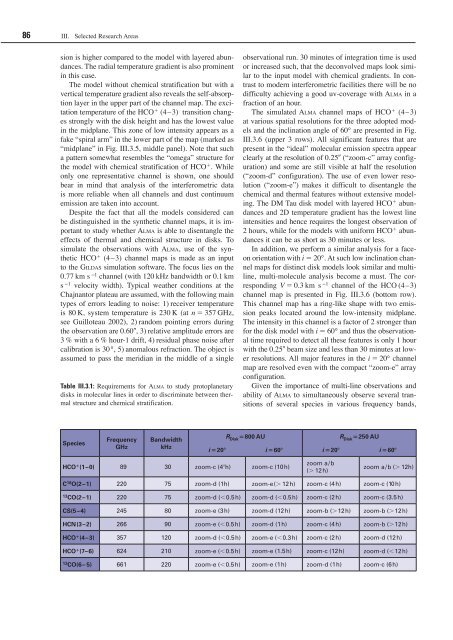Max Planck Institute for Astronomy - Annual Report 2007
Max Planck Institute for Astronomy - Annual Report 2007
Max Planck Institute for Astronomy - Annual Report 2007
You also want an ePaper? Increase the reach of your titles
YUMPU automatically turns print PDFs into web optimized ePapers that Google loves.
86 III. Selected Research Areas<br />
sion is higher compared to the model with layered abundances.<br />
The radial temperature gradient is also prominent<br />
in this case.<br />
The model without chemical stratification but with a<br />
vertical temperature gradient also reveals the self-absorption<br />
layer in the upper part of the channel map. The excitation<br />
temperature of the HCO (4–3) transition changes<br />
strongly with the disk height and has the lowest value<br />
in the midplane. This zone of low intensity appears as a<br />
fake “spiral arm” in the lower part of the map (marked as<br />
“midplane” in Fig. III.3.5, middle panel). Note that such<br />
a pattern somewhat resembles the “omega” structure <strong>for</strong><br />
the model with chemical stratification of HCO . While<br />
only one representative channel is shown, one should<br />
bear in mind that analysis of the interferometric data<br />
is more reliable when all channels and dust continuum<br />
emission are taken into account.<br />
Despite the fact that all the models considered can<br />
be distinguished in the synthetic channel maps, it is important<br />
to study whether al m a is able to disentangle the<br />
effects of thermal and chemical structure in disks. To<br />
simulate the observations with al m a , use of the synthetic<br />
HCO (4–3) channel maps is made as an input<br />
to the gi l d a S simulation software. The focus lies on the<br />
0.77 km s −1 channel (with 120 kHz bandwidth or 0.1 km<br />
s −1 velocity width). Typical weather conditions at the<br />
Chajnantor plateau are assumed, with the following main<br />
types of errors leading to noise: 1) receiver temperature<br />
is 80 K, system temperature is 230 K (at n 357 GHz,<br />
see Guilloteau 2002), 2) random pointing errors during<br />
the observation are 0.60, 3) relative amplitude errors are<br />
3 % with a 6 % hour-1 drift, 4) residual phase noise after<br />
calibration is 30°, 5) anomalous refraction. The object is<br />
assumed to pass the meridian in the middle of a single<br />
Table III.3.1: Requirements <strong>for</strong> al m a to study protoplanetary<br />
disks in molecular lines in order to discriminate between thermal<br />
structure and chemical stratification.<br />
Species<br />
Frequency<br />
GHz<br />
Bandwidth<br />
kHz<br />
HCO (1–0) 89 30 zoom-c (4h) zoom-c (10h)<br />
observational run. 30 minutes of integration time is used<br />
or increased such, that the deconvolved maps look similar<br />
to the input model with chemical gradients. In contrast<br />
to modern interferometric facilities there will be no<br />
difficulty achieving a good uv-coverage with al m a in a<br />
fraction of an hour.<br />
The simulated al m a channel maps of HCO (4–3)<br />
at various spatial resolutions <strong>for</strong> the three adopted models<br />
and the inclination angle of 60° are presented in Fig.<br />
III.3.6 (upper 3 rows). All significant features that are<br />
present in the “ideal” molecular emission spectra appear<br />
clearly at the resolution of 0.25 (“zoom-c” array configuration)<br />
and some are still visible at half the resolution<br />
(“zoom-d” configuration). The use of even lower resolution<br />
(“zoom-e”) makes it difficult to disentangle the<br />
chemical and thermal features without extensive modeling.<br />
The DM Tau disk model with layered HCO abundances<br />
and 2D temperature gradient has the lowest line<br />
intensities and hence requires the longest observation of<br />
2 hours, while <strong>for</strong> the models with uni<strong>for</strong>m HCO abundances<br />
it can be as short as 30 minutes or less.<br />
In addition, we per<strong>for</strong>m a similar analysis <strong>for</strong> a faceon<br />
orientation with i 20°. At such low inclination channel<br />
maps <strong>for</strong> distinct disk models look similar and multiline,<br />
multi-molecule analysis become a must. The corresponding<br />
V 0.3 km s −1 channel of the HCO (4–3)<br />
channel map is presented in Fig. III.3.6 (bottom row).<br />
This channel map has a ring-like shape with two emission<br />
peaks located around the low-intensity midplane.<br />
The intensity in this channel is a factor of 2 stronger than<br />
<strong>for</strong> the disk model with i 60° and thus the observational<br />
time required to detect all these features is only 1 hour<br />
with the 0.25 beam size and less than 30 minutes at lower<br />
resolutions. All major features in the i 20° channel<br />
map are resolved even with the compact “zoom-e” array<br />
configuration.<br />
Given the importance of multi-line observations and<br />
ability of al m a to simultaneously observe several transitions<br />
of several species in various frequency bands,<br />
R Disk 800 AU R Disk 250 AU<br />
i 20 i 60 i 20 i 60<br />
zoom a/b<br />
( 12h)<br />
zoom a/b ( 12h)<br />
C 18 O(2–1) 220 75 zoom-d (1h) zoom-e( 12h) zoom-c (4h) zoom-c (10h)<br />
13 CO(2–1) 220 75 zoom-d (0.5h) zoom-d (0.5h) zoom-c (2h) zoom-c (3.5h)<br />
CS(5–4) 245 80 zoom-e (3h) zoom-d (12h) zoom-b (12h) zoom-b (12h)<br />
HCN(3–2) 266 90 zoom-e (0.5h) zoom-d (1h) zoom-c (4h) zoom-b (12h)<br />
HCO (4–3) 357 120 zoom-d (0.5h) zoom-e (0.3h) zoom-c (2h) zoom-d (12h)<br />
HCO (7–6) 624 210 zoom-e (0.5h) zoom-e (1.5h) zoom-c (12h) zoom-d (12h)<br />
13 CO(6– 5) 661 220 zoom-e (0.5h) zoom-e (1h) zoom-d (1h) zoom-c (6h)

















